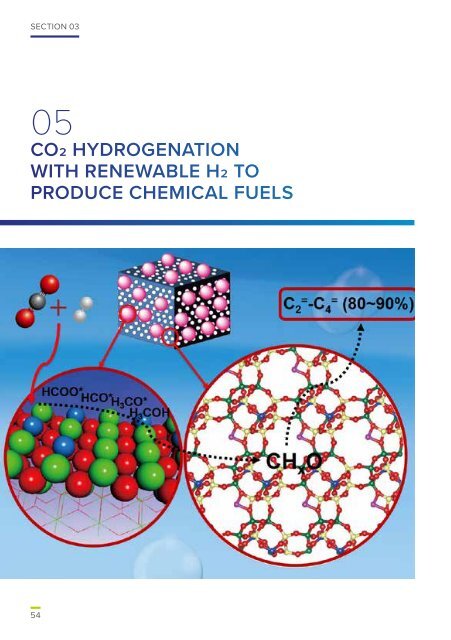MI 2020 Solutions FINAL
You also want an ePaper? Increase the reach of your titles
YUMPU automatically turns print PDFs into web optimized ePapers that Google loves.
SECTION 03<br />
FUELS<br />
05<br />
CO2 HYDROGENATION<br />
WITH RENEWABLE H2 TO<br />
PRODUCE CHE<strong>MI</strong>CAL FUELS<br />
CHALLENGE<br />
The direct production of liquid<br />
fuels from carbon dioxide<br />
hydrogenation has attracted<br />
enormous interest for its significant<br />
role in mitigating emissions and<br />
reducing dependence on fossil<br />
fuels. That is provided that the<br />
hydrogen (H2) is from renewable<br />
sources, such as photocatalytic<br />
or photoelectrochemical<br />
splitting of water.<br />
INNOVATION<br />
In 2017, scientists in China<br />
developed a variety of catalysts<br />
to covert carbon dioxide (CO2) to<br />
methanol, gasoline hydrocarbons,<br />
and even lower olefins with<br />
high selectivity and conversion<br />
efficiency under relatively mild<br />
experimental conditions.<br />
Development of these CO2<br />
hydrogenation catalysts makes it<br />
possible to reduce CO2 emissions<br />
and convert CO2 to value added<br />
chemicals, such as fuels and<br />
chemical feedstocks in large scale.<br />
Dalian Institute of Chemical<br />
Physics (DICP) has developed<br />
a ZnO-ZrO2 solid solution<br />
catalyst, which can achieve CO2<br />
to methanol selectivity of 86-<br />
91% with conversion efficiency<br />
of more than 10% under reaction<br />
conditions of 5.0 MPa, 24,000 ml/<br />
(g hour), H2/CO2 = 3:1 to 4:1, 320°<br />
to 315°C. The catalyst showed<br />
high stability for at least 500<br />
hours on stream and resistance to<br />
sintering at higher temperatures.<br />
The DICP team also achieved<br />
selective conversion of CO2<br />
to lower olefins through CO2<br />
hydrogenation over a ZnZrO/<br />
SAPO tandem catalyst. The<br />
selectivity for lower olefins was<br />
as high as 80−90%. Furthermore,<br />
this catalyst is stable toward the<br />
thermal and sulfur treatments.<br />
DICP has also reported a highly<br />
efficient, stable and multifunctional<br />
Na–Fe3O4/HZSM-5 catalyst. It can<br />
directly convert CO2 to gasolinerange<br />
(C5–C11) hydrocarbons<br />
with selectivity up to 78% of all<br />
hydrocarbons, while only 4%<br />
methane at a CO2 conversion<br />
of 22% and remarkable stability<br />
for 1,000 hours on stream.<br />
ACTION<br />
The technologies attracted<br />
extensive attention from the<br />
industrial sector and now the<br />
process is going through a<br />
pilot phase to scale up the<br />
experimental solutions in China.<br />
POTENTIAL<br />
This breakthrough may rapidly<br />
accelerate CO2 utilisation in<br />
industry, thereby reducing<br />
global emissions.<br />
CHINA<br />
54 55


